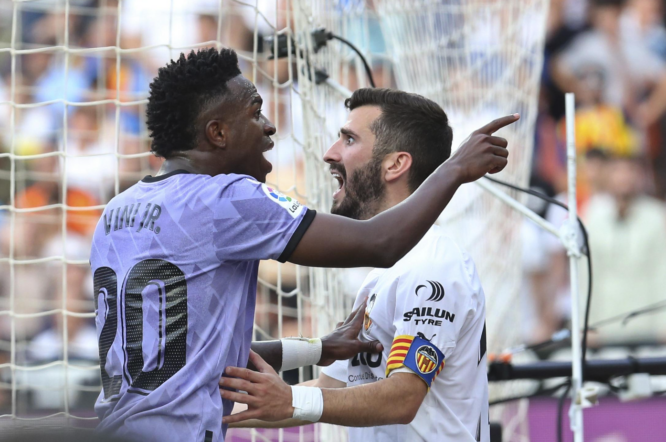Madrid’s highway bridge displays an effigy of a famous Black soccer player, emphasizing European sport’s racism.
Signs abound.
Black player scored in Italy to monkey chants in April. After scoring a penalty, a hostile north London crowd tossed a banana peel at a Black player. Black men’s national team members were racially harassed online in France after losing last year’s World Cup final.
Look outside Europe.
Last year’s Australia Cup final featured Nazi chants and monkey noises. South American Copa Libertadores matches contain monkey chants. Arab fans have taunted black sub-Saharan African footballers traveling North Africa.
Social media and a growing readiness to call out soccer racism—mostly in Europe but worldwide—has intensified. 11 years ago, FIFA president Sepp Blatter criticized racism in soccer and suggested resolving disputes with a handshake.
Real Madrid’s 22-year-old Brazilian soccer star Vinícius Júnior receives the most vicious, persistent, and high-profile racial comments.

In January, an overpass near Madrid’s training facility had a Vinícius effigy. Two weeks ago, a fan called Vinícius a monkey and made monkey noises, bringing him to tears.
Vinícius is leading Black anti-racism efforts in the world’s most popular sport.
“I have a purpose in life,” he added. “If I have to keep suffering so that future generations won’t have to go through these types of situations, I’m ready and prepared.”
Vinícius’ biggest concern is that Spanish soccer officials are doing little to stop the abuse, tolerating racism in a country where he has played since 18.
Despite FIFA’s 2013 authorisation, federations worldwide have been slow—or unwilling—to penalize teams for racist fan behaviour.
Fines? Sure. Closing stadiums? Point deductions, competition bans? Financial mismanagement, not player racism, is typical.
Black athletes and protectors feel helpless and irritated. Real Madrid coach Carlo Ancelotti said, “Nothing.”
Anti-racism activities and slogans are praised but increasingly perceived as tokenism, especially when clubs or federations receive modest fines for fan racist abuse.
UEFA fined the Spanish soccer association $25,000 for supporters racially harassing a Black Italy player during the 2012 European Championship, but a Denmark player was penalized five times that amount for displaying bookmaker underwear.
After Vinícius’ latest remark, global outrage and solidarity may turn Spain against racism, experts say. The Spanish league wants additional sanctions power after protests outside the Sao Paulo consulate. It finds and denounces cases and sends evidence to courts, where charges are frequently dismissed.
Jacco van Sterkenburg, a professor of race, inclusion, and communication in soccer and the media at Erasmus University in Rotterdam, said explicit racism in stadiums is more accepted and normalized in some parts of Spanish and southern European soccer culture than in England and the Netherlands, where media, former players, and soccer federations have openly addressed the issue.
Van Sterkenburg cautioned in a video conference that if a football organization doesn’t strongly oppose it and reinforce that message, it will return. “Repeat that this isn’t accepted.”
Repeat if no response. Some clubs play the message even when nothing happens. It’s always standard.”
Jermaine Scott, an associate history professor at Florida Atlantic University, told the AP that while overt racism is no longer an issue in mainstream American sports, institutional racism is visible in the paucity of Black, Indigenous, and people of color coaches and executives. European soccer has institutional racism.

Scott may believe Vinícius defies European soccer.
“As soccer spread throughout the world, different cultures made the game their own, and instilled different values, like creativity and innovation, and importantly, joy and some would say freedom,” Scott said.
“When a player like Viní Jr. plays with the classic Afro-Brazilian style, accompanied by samba celebrations, it upsets the value system of European soccer, which has historically disciplined those who challenge such value systems.”
British Kick It Out and French LICRA help soccer battle racism. The Fare network, a pan-European anti-racism group, deploys undercover observers to Europe’s biggest games to uncover racist chants and extremist flags.
Fans report racist incidents to federations and campaign organizations or post recordings and photographs on social media, which authorities utilize to punish abusers.
Previously isolated to stadiums, social media has escalated soccer’s racist abuse.
Racist tweets and Instagram remarks to the world’s best players are now anonymous. Soccer players advertise on mistreated sites.
Vinícius, Eto’o, Balotelli, and Lukaku denounce racism. The 1980s’ first Black Chelsea player, Paul Canoville, wishes he had.
Canoville advised Black players to speak up quickly. I learnt. I instruct new players.”
Van Sterkenburg and Scott suggested greater education and harsher punishments to reduce bias. A Spanish World Cup winner who was mistreated as Vinícius concurs.

